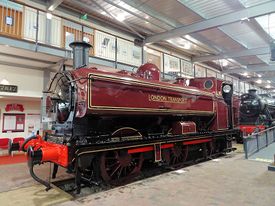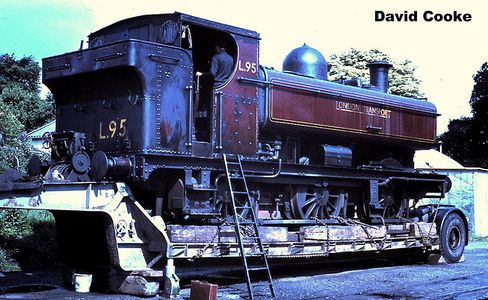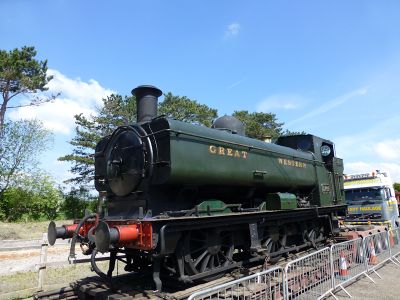GWR Pannier 5764
| GWR Pannier 5764 | |
|---|---|
 L95 (GWR 5764) in The Engine House | |
| Built By | GWR Swindon Works |
| Configuration | 0-6-0PT |
| Power class | GWR: C, BR(W): 4F |
| Axle load class | GWR: Blue (Yellow from 1950) |
| Status | Static display |
| Loco Number | 5764 |
| History | |
| Built | 1929 |
| Designed By | Charles Collett |
| Type | GWR 5700 |
| 1971 | Arrived on SVR in working order |
| 1989 | Re-entered service |
| 2001 | Re-entered service |
| 2011 | Withdrawn for overhaul |
| 2019 | Repainted in LT livery as L95 |
| Technical | |
| Length | 31ft 2" |
| Weight | 47t 10cwt |
| Tractive effort | 22,515 lb |
| Pressure | 200 lb/sq in |
5764 is a GWR Collett 5700 class 0-6-0PT ‘pannier tank’, one of two examples on the SVR (the other being 7714). The GWR 5700 class was the most numerous class of engine designed and built by the Great Western Railway; more than 860 were built between 1929 and 1950. Pannier tanks could be found at work all over the former GWR system and although designed primarily for shunting duties, they were regularly used on local freight and passenger workings. British Railways Western Region 'BR(W)' rated the class as 4F[1] although elsewhere the class was rated 3F.[2]
Contents
5764 in service
GWR / BR
5750-5799 were built at Swindon works 1929-1930 with vacuum brakes and steam heating. They were fitted with ATC in the following few years. 5764 entered service in 1929 at London’s Old Oak Common depot. It remained at that depot post-War, serving the GWR and BR for more than thirty years. Duties involved local freight and shunting in the West London area as well as ECS working in and out of Paddington station.
Although allocated to London throughout its working life, 5764 was photographed in the early 1960s at Longville on the Much Wenlock branch with future SVR resident Inspection Saloon 80972.[3][4] It was also photographed at Much Wenlock with a service for Wellington (Salop), thought to be in April 1960, which would have briefly crossed Severn Valley metals at Buildwas.[5] It was probably there on a running in turn after its last heavy overhaul which took place at the Wolverhampton Stafford Road works in February 1960. The locomotive returned to London following that overhaul, but was then withdrawn by BR in May 1960 having run an estimated 520,259 miles in service.
London Underground
BR sold a number of pannier tanks, including 5764, to London Transport who used them mainly to run PW and engineering trains on their Metropolitan Lines, operating from their Neasden Depot and also from Lillie Bridge, Kensington. While with London Underground, 5764 was allocated the number L95. By the end of 1963, recorded mileage had increased to 668,771.[6]
LT panniers returned to Swindon from time to time, the Stephenson Locomotive Society noted it in 'A' shop on 20 December 1964[7], as shown in this image of 5764 (L95) with GWR 9425 and 9457 at Swindon in January 1965.
5764 in preservation
The SVRA Kidderminster Branch set up a fund in 1970 to acquire one of the last three pannier tanks still in use at London Transport. Final negotiations were handled by Sir Gerald Nabarro and Richard Dunn as the Branch Committee considered a tender backed by the Company might be looked upon more favourably. The tender proved successful, with L95 (5764) being acquired by the SVR Pannier Tank Fund of the Kidderminster Branch on 24 May 1971.[8]
On Sunday 6 June 1971, L95 was scheduled to take part in an event billed as 'Farewell to Steam on the (London) Underground' together with the other two panniers L94 (7752) and L90 (7760). In the event L94 worked the 'Last Steam Train on the Underground' from Moorgate to Neasden Depot, while L90 provided working demonstrations within the Depot. L95 was not steamed as the locomotive had been found several months earlier to have a slipped tyre which had been 'spot welded' to keep it operational.[8]
5764 was moved by road to Bridgnorth, arriving on 19 June 1971 and entering service still in LT livery the same year.[6] An indication of how quickly it entered service may be judged by the lighting of a fire in the engine whilst it was being unloaded from the low-loader.
5764 was repainted into GWR livery in 1972. During the next few years 5764 made appearances in the BBC television series Carrie's War in November 1973 and The Signalman in 1976. The early success of 5764 led the SVRA Kidderminster Branch to purchase a second pannier, 7714, in 1973.
In early 1977 a slipped tyre led to 5764 being withdrawn from service.[9] In summer 1978, SVR News announced that another pannier, 3612, had been acquired from Barry to provide new wheels for 5764 as well as a spare boiler for 5764 and 7714.[10] After re-profiling on the Noble and Lund wheel lathe, the new wheels were installed and the locomotive re-painted in time for a return to service in mid-1979. One of the first duties was for the filming of the BBC TV series God's Wonderful Railway that year.[11] In the following year she performed in Granada TV's The Good Soldier.[12]
5764 was withdrawn from service in 1982 awaiting a heavy overhaul. The locomotive was steamed again in early 1989; the first test movement in steam being an unusual sight because the tanks had not been fitted! By June of that year a full return to service had been achieved in time for an appearance in the summer steam gala.[13] During the course of the 10 year ‘ticket’ that followed, 5764 spent 1993 on hire to the South Devon Railway. 1995 saw another film appearance in Feast of July and 1998 a television appearance in the TV movie Cider With Rosie; service ended later that year.
Following a boiler exchange made possible by the 1978 acquisition of a ‘spare’,[14] 5764 entered a third period of service in summer 2001.[15] During this 'ticket' Bradford on Avon station master and SVR volunteer David Walden, with others, successfully arranged for 5764 to be displayed on a low loader in 2006 in Box village for the 'Brunel 200 anniversary' celebrations, and the following year in steam at 'Bradford-on-Avon 150'.[16]
5764 was withdrawn from service in January 2011 on the expiry of the boiler certificate. The locomotive then moved into The Engine House on display in May 2011, but was removed to make a guest appearance as a static exhibit at the Gloucester Warwickshire Steam Railway’s Broadway station in May 2013.
It was then stored in Kidderminster Carriage Shed, making subsequent appearances as a static exhibit at Worcester Racecourse in 2015 and the Step Back to the 1940s event in 2017.
On 20 June 2018 5764 was moved from storage in Kidderminster Carriage Shed to be put back on display in The Engine House. A move to Bridgnorth for a cosmetic repaint then took place on 16 November 2018.[17] 5764 moved to the Engine House in her LT guise as L95 in March 2019.[18]
The locomotive is owned by the SVR Pannier Tank Fund who also own GWR Pannier 7714.
See also
Steam Locomotives
SVR-based locomotives visiting other events
Locomotives running under different identities
Tales from the Severn Valley
Classes of locomotives used on the Severn Valley Branch in commercial service
References
- ↑ Midlands Division (Ex WR) & Gloucester District - Locomotive Route Availability (Branch Lines)- June 1963 Retrieved 7 January 2017
- ↑ Classic British Steam Locomotives (ISBN 1-86147-138-6), Wikipedia etc
- ↑ Photo in SVR News 55
- ↑ SVR News 155 'New Arrivals' (Hugh McQuade)
- ↑ 5764 Much Wenlock 0460 MD764, Rail Photoprints, ©A. J. B. Dodd (Retrieved 31 October 2021)
- ↑ 6.0 6.1 SVR Stock Book 9th Edition
- ↑ BR database
- ↑ 8.0 8.1 SVR News 177, 'Forty Years of Pannier Tank 5764', Peter Hudson
- ↑ SVR News 44
- ↑ SVR News 48
- ↑ SVR News 51-53
- ↑ The Good Soldier, Youtube (Retrieved 18 February 2017)
- ↑ SVR News 92-93
- ↑ SVR News 133
- ↑ SVR News 136
- ↑ Evry, Craig, 'Train anniversary event still on track', Wiltshire Times 3 July 2007 (Retrieved 25 May 2024)
- ↑ SVR-Online Forum
- ↑ The Railway Magazine, January 2019, p. 8
Links
| ||||||||||||||||||||||||||||||||||||||||||||||||||||||||








